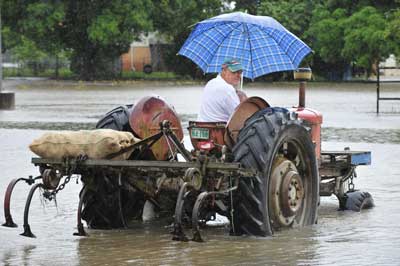
“I SEE A cloud no bigger than a man’s hand.” (1 Kings 18:44 )
Elijah might have been standing near Bedourie late last year near the end of four years without a wet season. Drought had crippled both properties and people throughout northwest Queensland.
But by Easter 2009, the area was struggling to recover from floods.
Some rain may have been welcome, but the water that should have brought on the much-needed grass has been sitting for so long the green shoots have rotted.
The huge downpour in February was in fact so extreme that McKay Patrol minister Rev Garry Hardingham said many people in the region are now echoing Jesus’ words: “My God, why have you forsaken me?”
“The isolation of the floods has generated God questions among property folk,” Mr Hardingham said. “In normal times, there’s not much of that. But after years of drought when they expected a break, they’ve now been cut off completely and many want to know where God is now.”
The impact on the church has been similar to the effect on grazing, tourism, education, and other aspects of everyday life in the Gulf Country.
It was Easter when the congregation in Karumba were finally able to gather for their first worship service of 2009.
Normally padded with grey nomad travellers and tourists, the crowd consisted mostly of locals in the prawn trawling town.
The tiny towns of Julia Creek and McKinlay also treasure their church services each month. But there was no way into town for Mr Hardingham or any property folk until March this year.
After a record number of flying hours, including 47 food drops as well as medical and school shuttles, Mr Hardingham thought there would probably be two or three people gathered in McKinlay for his church service.
“There were only two of the regulars but there was also an entire family of newcomers who wanted to connect,” he said.
For old hands like these regulars, this was initially just another wet season.
But after weeks of isolation, even these veterans were starting to run short of supplies.
With its balloon tyres, short take-off and landing performance, and good payload, the Uniting Church Cessna was a great tool for isolated families in the region.
Mr Hardingham and photographer Lyn Vernon delivered groceries and refreshments to Kajabbi (118 km north east of Mt Isa) at a time when a box of capsicums was looking good to the locals.
In Karumba, where a barge brought dry goods all the way around from Cairns, Mr Hardingham’s load of fresh dairy products was also a godsend.
He said there was an opportunity amidst the floods for the rest of the church in Queensland to help in the region, particularly as the huge spike in flying will have a big impact on the availability of his aerial patrol this year.
In the eyes of the government, the Uniting Church aircraft is privately owned and as a result, its flood relief efforts were not funded from state coffers.
In Ingham on the east coast, Rev Ian Boudry’s congregation has taken on a new twist to a New Testament idea. Rather than visiting the sick with olive oil, they’re helping the elderly and unwell with bleach and oil of cloves.
The people of Ingham know about floods. The old hands built high set homes and they have almost as many boats as cars.
They also know what happens in the weeks that follow a big wet: mould. The constant damp and summer temperatures are perfect for mould spores.
So as walls and ceilings grow black, Uniting Church members have been helping residents who are not strong enough for the big task of scrubbing down their houses.
“The government agencies do the big picture work, and they do it well in a community that fully understands the effects of floods,” Rev Boudry said. “But the church picks up individuals who fall through the cracks.”
Ingham’s church building was thankfully out of reach of flood waters.
It was, however, cut off from the other side of town for some time, with the only access via a rail bridge over Palm Creek.
Mr Boudry estimated there is still about two months of work cleaning up in Ingham.
The economic wash-up won’t be fully felt until late 2009 or early 2010 when the damage to the cane crop shows in a poor harvest.
Photo : An Ingham fruit and vegetable merchant delivers potatoes in the rain. Photo by Troy Rogers and courtesy of The Townsville Bulletin
 JourneyOnline
JourneyOnline






